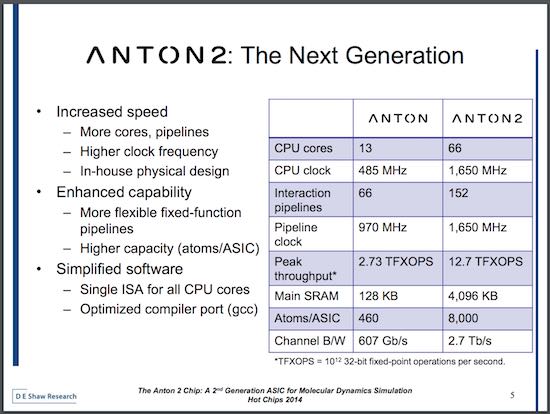 Today the Pittsburgh Supercomputing Center (PSC) announced a $1.8-million National Institutes of Health grant to make the next-generation Anton 2 supercomputer developed by D. E. Shaw Research (DESRES) available to the biomedical research community. A specialized system for modeling the function and dynamics of biomolecules, the Anton 2 machine at PSC will be the only one of its kind publicly available to U.S. scientists. The grant also extends the operation of the Anton 1 supercomputer currently at PSC until the new Anton 2 is deployed, expected in the Fall of 2016.
Today the Pittsburgh Supercomputing Center (PSC) announced a $1.8-million National Institutes of Health grant to make the next-generation Anton 2 supercomputer developed by D. E. Shaw Research (DESRES) available to the biomedical research community. A specialized system for modeling the function and dynamics of biomolecules, the Anton 2 machine at PSC will be the only one of its kind publicly available to U.S. scientists. The grant also extends the operation of the Anton 1 supercomputer currently at PSC until the new Anton 2 is deployed, expected in the Fall of 2016.
Many life processes important to understanding the molecular basis of cellular events occur over timescales exceeding a millisecond in length,” says Phil Blood, principal investigator of the new grant and senior computational scientist at PSC. “Anton 2’s performance for molecular simulation will exceed that of current general-purpose supercomputing systems by orders of magnitude, enabling the study of biological processes not otherwise possible and offering new possibilities in drug discovery and development.”
Molecular dynamics simulations can provide insights into the behavior of proteins, cell membranes, nucleic acids and other molecules at the atomic scale. But even the most advanced general-purpose supercomputers struggle to simulate beyond the microsecond level—a thousand times shorter than the millisecond level—without taking months of computational time. Anton has changed this, giving researchers practical access to simulations at far longer timescales.
The Anton 1 supercomputer that has been in use at PSC since 2010 has been a great success and has so far enabled 277 simulation projects by 127 different PIs across the US and resulted in more than 120 peer-reviewed research papers. Three of these studies appeared in the scientific journal Nature, one of the international scientific community’s premier publications.
The new 128-node Anton 2 will expand on the power and capabilities of the Anton 1 currently at PSC, increasing simulation speed approximately four-fold and enabling the simulation of biomolecular systems with around five times as many atoms as was possible using the previous machine. These capabilities will allow researchers to study larger biomolecules on timescales that weren’t previously accessible to molecular dynamics modeling.
As with Anton 1, DESRES will provide the Anton 2 system without cost for non-commercial use by U.S. researchers. Time on the machine is expected to be allotted on the basis of research proposals submitted to an independent expert committee convened by the National Research Council at the National Academy of Sciences.




